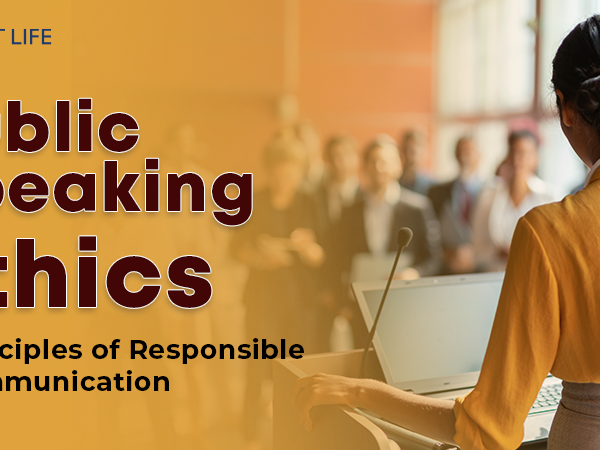Public speaking can be a challenge for introverts. Fortunately, with the right strategies, success can be achieved. This article provides helpful tips and techniques to help introverts overcome their shyness and become successful in speaking in public.
Public speaking is usually associated with extroverts who enjoy socializing. Yet, many introverts have an innate ability to connect with their audience by delivering thoughtful and prepared speeches. By tapping into their introspection, introverts can give powerful presentations that leave a lasting impression.
When it comes to speaking in public, introverts have an advantage. They excel when they have time to think and practice their speeches. With careful research and preparation, introverts can make sure their talks are well-structured and engaging.
To improve their public speaking skills, introverts can focus on developing effective communication techniques. Storytelling, using visuals, and employing body language – these are all ways to captivate an audience and deliver their message effectively.
An example of an introvert who became a great public speaker is Abraham Lincoln. Despite his quiet nature, he practiced and gained experience, eventually becoming a renowned orator. His speeches during the Civil War era united the nation and earned him a place as one of America’s greatest presidents.
Understanding Public Speaking for Introverts
To navigate the world of public speaking for introverts, gain a deeper understanding of the challenges they face. Explore the obstacles introverts encounter in the realm of public speaking, and uncover effective strategies to overcome them successfully.
Exploring the Challenges Faced by Introverts in Public Speaking
Public speaking can pose challenges for introverts. These people may feel overwhelmed when addressing big crowds. They have to project their voice and presence, which can be hard. Introverts are more comfortable with listening and observing, not being in the spotlight. Plus, connecting with listeners emotionally is often required. Networking is another challenge, as small talk can be draining or uncomfortable.
To overcome these hurdles, introverts should use their strengths and find strategies that work. Preparation and practice help build confidence. Incorporating personal style into delivery can add authenticity.
So, introverts, make yourselves heard! Embrace discomfort and seize public speaking opportunities. Don’t let fear of missing out hold you back. Share your perspectives and insights with the world. Step onto the stage, let your voice soar, and leave an impact on your audience. You got this!
Also Read: Find Your Passion: A Path to Self-Discovery and Fulfillment
Strategies for Overcoming – Public Speaking for Introverts
To overcome introversion in public speaking, employ strategies that leverage your strengths. Recognize and embrace introversion as a strength, mentally and physically prepare for speaking engagements, practice in a comfortable environment, and utilize visual aids and props for effective communication.
Recognizing and Embracing Introversion as a Strength
Acknowledge introversion as a strength for public speaking! It allows folks to tap into their one-of-a-kind qualities and perform brilliantly.
- 1. Introverts hear and comprehend others well, connecting with the audience.
- 2. They can thoughtfully plan their speeches, with words that come from the heart.
- 3. Their empathy lets them deliver messages that others can relate to.
It’s key to know that introversion is not a hindrance but rather a special viewpoint that can fascinate listeners.
Moreover, introverts have brilliant creativity and analytical skills. This helps them formulate remarkable talks with original concepts and astute analysis.
Finally, it’s essential for introverts to recognize that they have something to offer the world. By expressing their views, they can motivate others and have a positive effect on public speaking.
Preparing Mentally and Physically for Public Speaking
Mentally and physically preparing for public speaking is a must! With a structured approach, you can be a pro in no time. Here’s a 4-step guide to help you out:
- Visualize success: Close your eyes, imagine yourself delivering a captivating speech with confidence. Imagine the positive outcomes, applause, and audience engagement. This will boost your confidence and reduce anxiety.
- Practice deep breathing: Slow, deep breaths fill your lungs completely and exhale slowly. Focus on releasing tension and allow relaxation.
- Warm-up exercises: Like athletes do before a game, speakers should warm up their voices. Perform vocal exercises like tongue twisters or humming to relax your vocal cords and improve speech clarity.
- Engage in power poses: Stand tall with an open posture to increase feelings of confidence and authority. Power poses send signals to your brain, triggering positive emotions.
Additionally, you can:
- Get feedback from trusted individuals.
- Analyze other successful speakers.
- Rehearse in front of a mirror or record yourself to identify body language.
- Break down your speech into sections or key points for easier memorization.
- Remind yourself that nerves are natural, they can be channeled into energy for a great performance.
Follow these tips and you’ll have improved self-confidence while speaking publicly!
Practicing and Rehearsing in a Comfortable Environment
Introverts who want to beat their fear of public speaking must practice and rehearse in a cozy environment. This way, they can build their trust and hone their abilities without the stress of an audience. Here’s a 6-step guide on how to do just that:
- Find a calm, personal spot. This could be your bedroom, office, or anyplace where you won’t be disturbed.
- Set the mood. Dim the lights, play some music, or light scented candles to make a tranquil atmosphere.
- Picture success. Close your eyes and imagine yourself giving a flawless speech. Picture the crowd’s positive response and your own assurance radiating through.
- Record yourself. Use a recorder to capture your practice sessions. This allows you to review your performance objectively and spot things that need improving.
- Use props. If relevant to your speech, incorporate props or visuals during practice. This helps you become more comfortable with them and improves your presentation.
- Get feedback. Share your recorded practice sessions with someone you trust who can provide useful criticism and advice.
Be brave and accept discomfort, but make sure you have a pleasant environment while practicing public speaking. Have realistic expectations too, as conquering introversion takes time and effort.
Let me tell you a story: Sarah was an introverted student who had always struggled with public speaking since school. She wanted to get better before an important presentation, so she created a rehearsal area in her room – with gentle lighting and peaceful music. She rehearsed avidly, focusing on her body language and voice volume. With each session, Sarah’s confidence grew, and eventually, she delivered her presentation without a hitch. Her hard work had paid off, and she was pleasantly surprised by her progress.
This guide and story prove that, with dedication and commitment, conquering introversion in public speaking is possible.
Utilizing Visual Aids and Props to Enhance Communication
Visual aids and props are essential for improving communication during public talks. They work as strong tools to fascinate the listeners and transfer information accurately. By employing visual aids and props, speakers can make an energetic and interactive address that fascinates their audience.
Types of Visual Aids
- Infographics: These visually pleasing graphics display intricate information in a clear and simple manner. They help speakers communicate facts, statistics, or comparison charts with ease.
- Charts: Whether it’s a bar graph, pie chart, or line graph, charts are great visual tools for presenting numerical data. They help speakers show information clearly and make it simpler for the audience.
- Slides: PowerPoint slides are usually used in presentations as they enable speakers to include text, visuals, and multimedia components smoothly. Slides give structure to the speech and make it more attractive.
- Videos: Videos are potent communication devices that can evoke emotions and pass messages efficiently. Speakers can use videos to display demonstrations, interviews, or testimonials related to their topic.
- Diagrams: Diagrams are visual representations that simplify complex concepts or processes. From flowcharts to mind maps, diagrams encourage comprehension by breaking down complicated thoughts into manageable parts.
- Photographs: Pictures capture attention quickly and can express sentiments or tell stories. Speakers can use photographs wisely to boost their message or offer vivid examples.
Using visual aids and props is a successful strategy for overcoming introversion in public speaking. They allow introverted speakers to divert some attention away from themselves and focus on the visuals, providing comfort and support.
Also Read: Techniques for Innovative Thinking: Boost Creative Thinking
Techniques – Delivering Speech: Public Speaking for Introverts
To deliver a successful public speech, master the techniques such as managing nervousness and anxiety, using pauses and body language effectively, and engaging the audience through authenticity and storytelling. These strategies will empower introverts to step on stage, captivate the crowd, and leave a lasting impact.
Managing Nervousness and Anxiety
Delivering a public speech? Nerves and anxiety can be conquered! Try deep breathing exercises. Take a deep breath in through your nose, and long breath out through your mouth. Visualize success. Imagine yourself standing tall and delivering your speech, with the audience applauding your impactful presentation.
Practice mindfulness meditation too. Stay present in the moment and don’t worry about the future or past mistakes. Everyone gets nervous, so use these techniques to overcome anxiety and give a great speech!
Using Pauses and Body Language Effectively
To deliver a successful public speech, using pauses and body language effectively is key! These techniques not just capture the audience’s attention, but also enhance the impact of your message. To master this skill, here are 6 steps:
- Utilize strategic pauses. Break up your speech with carefully-timed pauses to emphasize important points and let the audience take in the information.
- Maintain eye contact. Catch individuals in the audience’s eyes to create a connection and show sincerity and confidence.
- Gesture purposefully. Use hand gestures to illustrate concepts or emphasize words/phrases – ensure they’re natural and fit your speech.
- Control your posture. Stand tall with an open posture, exuding confidence and authority. Don’t slouch or cross your arms – it can look disinterested or defensive.
- Utilize facial expressions. Be aware of your facial expressions, reflecting the tone and emotion of your speech. Smiling when appropriate helps create rapport with the audience.
- Practice mirroring. Observe the body language of engaged audience members and subtly mirror their gestures and movements. This helps build rapport and creates a positive speaking environment.
Using pauses and body language is not just about looks – it has a huge part to play in conveying authenticity, confidence, and credibility. Examples from history show us that impactful use of pauses and body language can amplify messages. Take Abraham Lincoln’s iconic speeches – his deliberate use of pauses allowed his words to resonate deeply with his listeners.
By understanding the power of well-utilized pauses and body language, you can upgrade your public speaking skills beyond just words. Captivate audiences with impactful non-verbal communication techniques that leave a lasting impression!
Engaging the Audience through Authenticity and Storytelling
Authenticity and storytelling are essential for a successful public speech. By being genuine and sharing personal stories, speakers can create a connection with the audience. This builds trust and credibility, which makes their message more relatable.
Storytelling adds an element of intrigue. Real-life examples and anecdotes bring the speech to life, evoking emotions and creating a lasting impact.
Other techniques to engage the audience include using visuals such as slides or props to convey complex information in a clear way. Maintaining eye contact with the audience is also key; it helps make them feel included and involved in the speech.
To conclude, authenticity and storytelling are key when delivering a public speech. These techniques help speakers connect with their listeners and make their message more impactful and memorable. Toastmasters International states that authentic communication increases an individual’s ability to influence others effectively.
Also Read: Impact of Physical Fitness: Boost Self-Improvement
Tips – Effective Preparation: Public Speaking for Introverts
To effectively prepare and organize your public speaking engagements, equip yourself with the necessary tools. Research and understand your audience and venue, structure your speech for clarity and coherence, and rehearse and refine your delivery. Reflecting on these sub-sections will help you conquer your introverted nature and deliver successful speeches with confidence.
Researching and Understanding the Audience and Venue
- Identifying the age, gender, and profession of the audience: It is not specified in the given text about the specific details of the age, gender, and profession of the audience. Therefore, it is not possible to determine these characteristics based on the given information.
- Taking into account the culture and values of the audience: Since the culture and values of the audience are not provided in the text, it is not possible to consider these factors in this context.
- Adapting the content and depth based on the audience’s understanding: Without knowing the audience’s level of understanding, it is difficult to determine the appropriate content and depth for the presentation.
- Matching the goals and expectations of the audience: The goals and expectations of the audience are not mentioned in the text, so it is not possible to align the aims of the presenter accordingly.
- Considering the size, layout, acoustics, and tech capabilities of the venue: The text does not provide any information about the venue, so it is not possible to adjust the presentation style based on these factors.
- Being aware of logistical difficulties or prohibitions: There is no mention of any specific logistical difficulties or prohibitions in the text, so it is not applicable in this context.
- Seeking feedback from prior presentations: While the text mentions the importance of feedback from prior presentations, it does not specify any details about previous presentations or related venues.
- Recognizing the value of understanding the audience: The text highlights the significance of presenters having an in-depth knowledge of their audience to give better presentations, based on research from Stanford University. This emphasizes the importance of understanding the audience’s characteristics, needs, and preferences.
Structuring the Speech for Clarity and Coherence
Structuring your speech properly is essential for clarity and coherence. Logically organizing your ideas allows you to effectively communicate your message to the audience, and keep their attention throughout.
A well-structured speech is like a well-organized table. Each column should represent a key aspect of the topic. For example, if you are speaking about climate change, the columns could include causes, effects, solutions, and future implications. This ensures that all relevant points are covered and presented in a coherent manner.
To make your speech clearer, it’s important to connect your ideas. Use transitional words like “Furthermore,” “Moreover,” or “Additionally” to smoothly move from one point to another. This helps the audience follow your line of thought.
Winston Churchill’s famous speeches during World War II show the importance of structuring. His carefully crafted speeches not only inspired the nation but also conveyed vital information effectively. By strategically organizing his words, he captivated the audience and left a lasting mark on history.
Rehearsing and Refining the Delivery
To deliver an impressive presentation, rehearsing and refining your delivery is essential. Here are some tips to master this skill:
- Perfect with practice: Rehearse your presentation repeatedly to get familiar with the content, timing and flow.
- Get feedback: Ask trusted colleagues or mentors for constructive criticism and make improvements.
- Body language matters: Pay attention to your posture, facial expressions and gestures to display confidence and engage your listeners.
- Vocal variety counts: Practice modulating your voice to emphasize key points, alter the pace and add drama when required.
- Timing is important: Check the allocated time frame by timing each part of your presentation during rehearsals.
- Enhance visuals: Refine the design and layout of slides or props to make them clear and visually pleasing.
Also, add eye-catching anecdotes or facts related to your topic during rehearsals. This will captivate your audience without deviating from the main message.
To make these tips effective, remember that practice builds confidence and feedback helps recognize any weak points. Body language displays credibility and vocal variety adds dimension to your delivery. Sticking to timings shows professionalism and refined visuals strengthen comprehension.
By using these strategies in your preparation process, you can deliver presentations that remain in the minds of your audience.
Also Read: Setting SMART Goals for Personal Growth: A Step-by-Step Guide
Overcoming Setbacks and Building Confidence
To overcome setbacks and build confidence in public speaking as an introvert, delve into the sub-sections: dealing with unexpected challenges or mistakes, seeking feedback, and continuously improving. These aspects offer valuable solutions to enhance your speaking skills and navigate the obstacles that may come your way.
Dealing with Unexpected Challenges or Mistakes
Dealing with unexpected challenges and mistakes is a part of life. It’s essential to manage them skilfully, in order to beat setbacks and increase confidence. Here are three key points to keep in mind:
- Growth mindset: Look at challenges as a chance to develop and learn. Having a growth mindset helps you see difficulties as short-term problems, not permanent failures. This point of view keeps you determined and motivated to discover solutions.
- Analysis: When challenges or mistakes appear, take some time to figure out what went wrong and why. This helps spot areas for improvement and gives useful data for future decisions. Understanding the sources helps create strategies to avoid similar issues in the future.
- Getting help: Seeking guidance when facing unexpected challenges and mistakes is critical. It can be consulting mentors, working with colleagues, or accessing resources. Reaching out to other people gives new perspectives and assistance in finding effective solutions.
Remember that bumps and mistakes are usual experiences for everyone, either in their personal or professional life. Being able to rise after these setbacks contributes to individual growth and builds resilience.
Psychologist Carol Dweck coined the term “growth mindset,” which emphasizes its importance in overcoming difficulties and achieving success (source: Stanford University).
Seeking Feedback and Continuously Improving
Growth and success depend on getting feedback and constantly bettering yourself. That means asking for input from everyone, examining it, and using it to improve. Here are five tips to get the most out of feedback:
- Get opinions from various sources: Ask colleagues, mentors, and peers for their views and ideas.
- Stay open-minded: Don’t take feedback as criticism; see it as a chance to learn and develop.
- Put feedback into action: Use it to make real progress on areas that need work.
- View failure as a learning experience: See setbacks as steps towards success and use them to your advantage.
- Continually assess your progress: Keep track of your development and make any necessary changes.
Remember, feedback is not only about compliments; it’s about identifying areas for improvement. By seeking feedback and improving yourself, you can feel more confident and reach greater success.
Here are some ideas to keep in mind when seeking feedback:
- Create a safe place for honest feedback: Make others comfortable giving you constructive criticism by building trust.
- Form an action plan based on feedback: Use it to create a plan of improvement with goals and deadlines.
- Get ongoing support: Find mentors or join helpful communities for guidance, motivation, and accountability.
- Reflect on both good and bad feedback: Learn from both positive and negative comments to understand your strengths and weaknesses.
- Keep improving: Remember that feedback is an ongoing process, not a one-time event. Embrace challenges and use them to grow.
By seeking feedback and continually improving, you can build your self-confidence, sharpen your abilities, and achieve your dreams. So start getting feedback today and unleash your potential!
Also Read: Top 100 Commonly Used A to Z Phrasal Verbs for English Fluency
Conclusion
Public speaking can be daunting for introverts. But there are ways to make public speaking a success. It’s essential to recognize that public speaking isn’t just about being outgoing. Introverts have special traits like deep thinking and listening. They can use these to create an intimate connection with their audience.
Preparation is also key. Introverts do well in structured settings. So, they should dedicate time to researching, organizing ideas, and practicing. Visualizing success and using relaxation techniques can help too.
According to a Harvard Business School study, people who were humble in their speech were rated more positively. So, embracing humility can help introverts engage their listeners and leave a lasting impression. Know More – The Fluent Life
FAQs – Public Speaking for Introverts
Q1: Can introverts be successful at public speaking?
A: Yes, absolutely! While introverts may find it more challenging, with the right strategies and preparation, they can excel in public speaking.
Q2: How can introverts prepare for public speaking?
A: Introverts can prepare by practicing their speech multiple times, focusing on deep breathing techniques to calm nerves, and visualizing a successful presentation.
Q3: What are some strategies for introverts to overcome stage fright?
A: Some strategies include starting with small, comfortable audiences, gradually increasing exposure to larger groups, and joining public speaking clubs or practicing with supportive friends.
Q4: Are there specific techniques introverts can use during a speech?
A: Yes, introverts can use techniques such as pausing for a brief moment before speaking, utilizing storytelling to engage the audience, and making eye contact with individuals rather than scanning the entire room.
Q5: How can introverts handle challenging questions or interruptions during a speech?
A: Introverts can handle such situations by taking a deep breath, clarifying the question if needed, taking a moment to think before responding, and handling interruptions gracefully by acknowledging the person and politely getting back on track.
Q6: How can introverts recharge after public speaking engagements?
A: Introverts can recharge by giving themselves time alone to reflect and relax, engaging in activities that recharge their energy, such as reading or spending time in nature, and practicing self-care.






